
The Impact of Covid-19 on Scratch Cooking in Schools
July 22, 2021 | By Anneliese Tanner
The COVID-19 pandemic presented many challenges for school districts that greatly impacted their serving efforts. We surveyed school food professionals to understand the financial implications and the state of scratch cooking in schools in the wake of Covid-19.
The Covid-19 pandemic forced schools to pivot service models overnight from daily congregant service to bulk, grab and go curbside service, amidst public health concerns, staffing challenges and supply shortages. As the pandemic pressed on, many school districts were serving students on-site in classrooms and cafeterias as well as providing curbside service for students learning virtually, requiring two service models simultaneously. As a result, some districts were serving more meals than before, while others were serving far fewer. These changes and challenges impacted the type of food school districts provided their students.
The Chef Ann Foundation (CAF) surveyed school food professionals to understand the financial implications and the state of scratch cooking in schools in the wake of Covid-19. The survey was sent out between April and July 2021 to school nutrition professionals across the country via email, social media and partner networks. School food professionals from 63 districts in 26 states, representing 1.2 million students, completed the survey. Forty seven of the responses (75%) were from districts with less than 10,000 students.
CAF conducted the survey to understand the extent to which the pandemic affected the amount of scratch cooking happening in schools. Scratch cooking in schools is crucial because, prior to the pandemic, 70% of the 30 million meals served daily were to students participating in the free and reduced price meal program, often students of color. Scratch-cooking improves student nutrition by reducing or eliminating foods high in added sugars, saturated fat, and sodium from meals and increasing the proportion of fresh produce served. To ensure that all students receive healthy and nutritious meals that allow them to thrive, scratch cooking must be a part of school meal programs.
CAF had heard anecdotally that schools were serving more processed, packaged food during the pandemic, wanted to confirm if this statement was true and, if so, understand why. CAF also wanted to understand what districts were planning for their menus in school year 2021-22 to see if the concessions made during the pandemic would remain. Having an idea of where districts are and what they are planning, grounded in data, will allow CAF to provide school districts support in recovering their menus from an extremely challenging year. CAF had also hoped to gather data to make the case for extending universal free meals for school year 2021-22, which happened while the survey was open.
Financial Impacts Varied Amongst Districts
Finances have a large role in dictating the type of production model in a district. Labor, the cost and the required amount can be a challenge to scratch cooking in schools, even in non-pandemic times.
Half of the districts anticipated a year-end deficit for school year 2020-21. Almost a third of the districts anticipated their deficit to be up to -$100,00. Of the districts anticipating a surplus, 17% projected a surplus of up to $100,000 and 21% projected $100,001-$500,000.
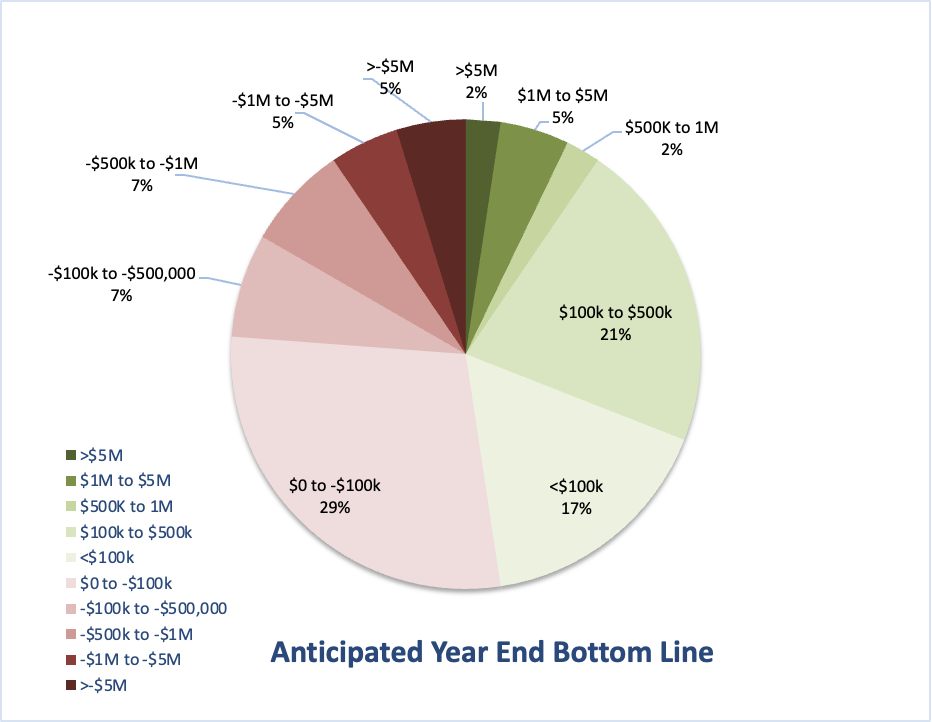
Three districts were unsure how their fund balance would be impacted. Of the remaining 64 districts, exactly half projected an increase to their fund balance. The surplus projections ranged from $46,000 to $16million. Similar to the finding in other research that 54% of districts reported financial losses for the 2019-20 school year averaging -$150,000 per district, the other 32 respondents to the CAF survey, 50%, projected a decrease to their fund balance with the majority of these deficit projections for -$100,000 or less.
We do not know how the surpluses and deficits compared to what the districts budgeted for, if any or all of the surplus was swept to cover other district costs or invested back into the program, or if deficits were covered or offset by the general fund in any way.
Of note since food service department revenue depends on the amount of meals served, less than a fifth of respondents served 75% or more of their regular participation, meaning the majority of school districts were serving less than ¾ of the meals they normally serve. Eighty percent of respondents served fewer meals, and while it could be assumed that 80% would then have a deficit since they had less revenue coming in, only half of the respondents (50% or 32 districts) expected to end the year with a deficit.
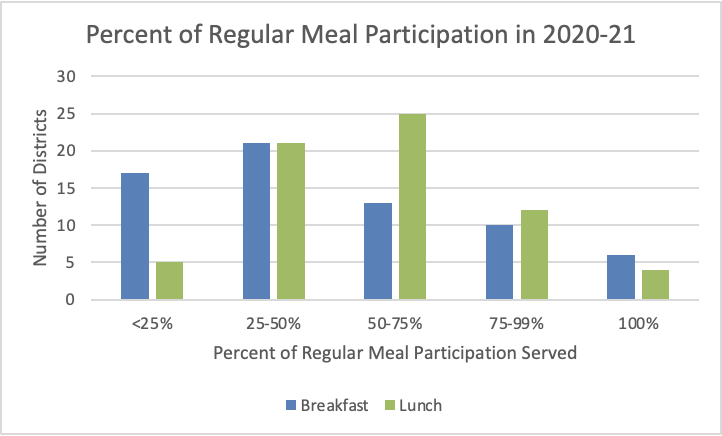
Increased Reimbursement Rates and the Power of Universal Free Meals
During the pandemic, the USDA increased reimbursement rates from $2.26 up to $2.3750 per meal for breakfast and from $3.60 up to $4.1525 per meal for lunch in schools where meals are prepared where they are served as well as in rural areas. These reimbursement rates were 5.1% and 15.3% higher than the previous free meal rate in severe need schools, where 40% or more of lunch meals served in the previous school year were served to students qualifying for meal benefits. Determining whether the cost savings (surplus despite decreased meal participation and revenue) came from increased reimbursement rates as a result of all meals being reimbursed at the free rate under the summer feeding programs, furloughed staff, open positions, cost savings on food or other reasons requires additional research.
Since districts receive reimbursement for each meal served and more students participate in meal programs when meals are free for all students, expanding the reach and impact of the meal program is extremely beneficial. Universal free meals will impact district budgets, bringing in more revenue that they can invest into scratch cook meal programs. Universal meals also create a more equitable meal program since districts can serve higher quality foods as a result of increased revenue, and no child is ever shamed or served an alternative meal because they cannot pay for their lunch. California and Maine have set a great example for the rest of the country by passing legislation to permanently provide all students with free school meals. To create greater food access for all students and provide support for districts to improve the quality of their meals, it is essential that the USDA also permanently extend universal meals beyond school year 2021-22.
Scratch Cooking Decreased During the Pandemic
Scratch cooking is the preparation of meals using whole ingredients that are unprocessed and/or minimally processed. Scratch cooking prioritizes raw proteins, whole grains, and fresh fruits and vegetables to create nutritious and delicious meals. Speed scratch cooking is using convenience or ready-made products, as well as fresh ingredients, to make a complete dish. Scratch cooking provides students exposure to healthful foods and improves their food choices. Scratch-cooking enables schools to serve the healthiest, tastiest meals so that kids are well-nourished and ready to learn.
The pandemic had a direct impact on the amount of scratch and speed scratch cooking in schools. In 2019-20, 11-25% of the menus offered at 19 districts were scratch cooked. During the pandemic, a third of those districts shifted away from scratch cooking, and the number of districts offering only 1-5% of their menu items from scratch doubled. Even the number of districts doing speed scratch decreased during the pandemic, indicating that school districts were heavily relying on pre-packaged and heat-and-serve items. While in the lower percent ranges there was an increase in speed scratch, likely districts going from scratch to speed scratch cooking, the number of districts offering 26-50% of their menu as speed scratch dropped by 25%.
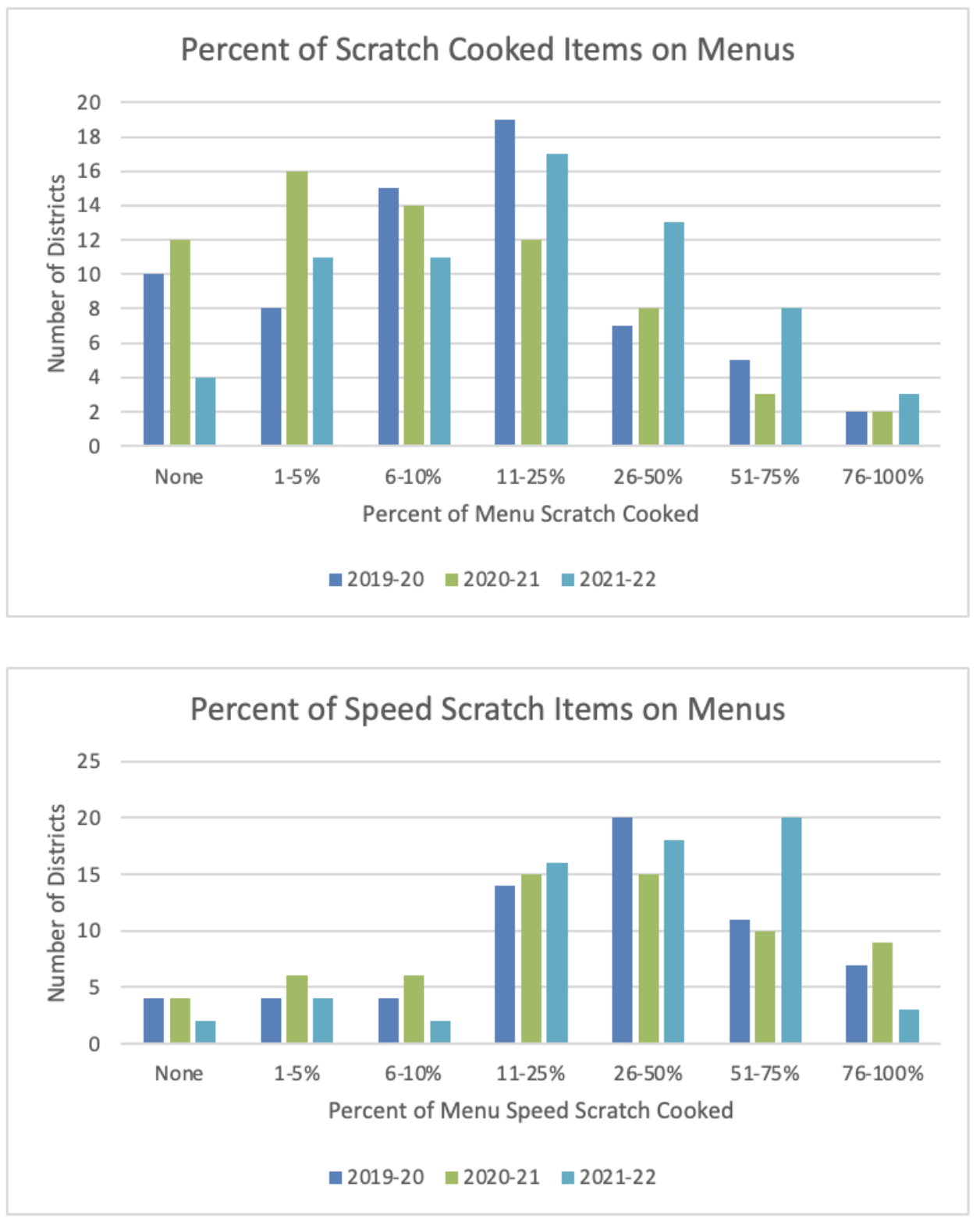
The silver lining is that the pandemic highlighted the importance of school food, and prompted a desire for fresher, scratch made food in schools, with school districts planning to increase the amount of scratch made offerings on their menus for the 2021-22 school year, over and above the 2019-20 levels. Whereas in 2019-20 ten districts reported no scratch cooking on their menus, only four plan not to scratch cook at all in 2021-22. Seven districts reported that 26-50% of their menu was scratch cooked in 2019-20. In 2021-22 almost double the number of districts plan to write menus with up to half of the items being scratch cooked and three more districts plan to increase scratch cooking on their menus to between 51 and 75%. Additionally, the number of districts planning on 51-75% of their menu being speed scratch is doubling from ten districts in 2020-21 and 11 in 2019-20 to 20 in 2021-22. Although these responses are from a small sample size, this information is an important frame for the need for scratch cooking support. Many districts are committing to increased scratch cooking after the pandemic and will need federal support to make that change and ensure it is sustainable for the long term.
The plans to increase scratch cooked items on school menus are promising for improved food quality. So that districts are able to implement plans to increase scratch cooking to the fullest extent, it is imperative that foundational support such as universal meals to expand access and revenue, funding for equipment and infrastructure as well as staff training and education to provide skill and capacity are in place. These factors, alongside scratch cooking, can help create a more equitable health and education system where all children, especially children of color, have regular access to high quality meals.
Challenges to Scratch Cooking during the Pandemic
It is encouraging to hear that districts have and plan to incorporate larger percentages of scratch and speed scratch items into their menus, and without a standard for measurement it is difficult to determine the true percentage of a menu that is scratch made. For example, if a district offers two menu items, one scratch made and one heat-and-serve, they may state that 50% of their menu is scratch cooked. However, if 80% of the students choose the heat-and-serve option, far less than half of the menu items being served are scratch cooked.
The number of districts reporting high amounts of scratch cooked items on their menus calls attention to the need for scratch and speed scratch definitions and a standard method of measuring percentage of scratch cooked items on a menu to be included in the Child Nutrition Reauthorization (CNR). Creating targets for scratch and speed scratch cooking that could be evaluated based on the top 20 items a district spends the most money on and/or evaluating ingredients versus products as percentages of overall inventory could create standards of measure around scratch cooking that would allow for research and analysis on the impacts of scratch cooking in schools.
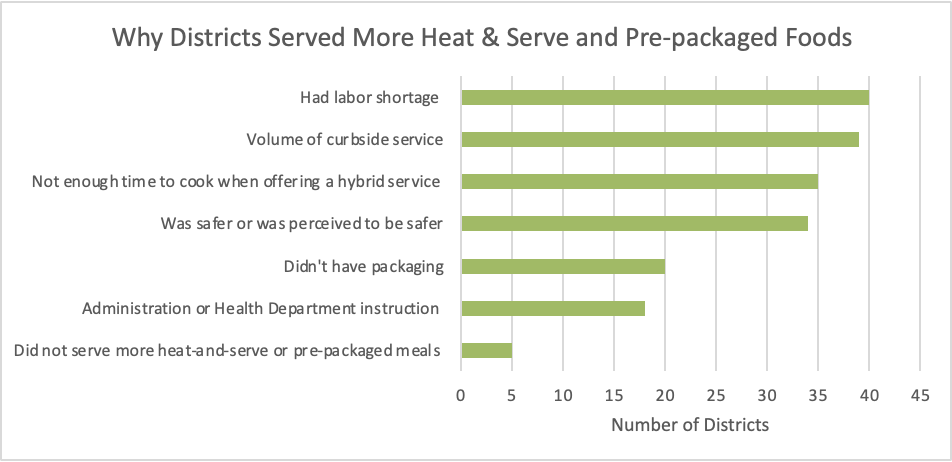
There were many challenges that prohibited districts from offering more scratch-cooked meals over the last year. When asked about why they served more pre-packaged or heat-and-serve foods during the pandemic:
- 5 districts, 7%, said they did not serve more heat-and-serve meals than in prior years, which, based on the number of districts who were not scratch cooking before the pandemic, could indicate that the majority of their menu prior to 2020-21 was heat-and-serve meals.
- 18 districts, 27%, were instructed by administrators or the health department
- 20 districts, 30%, didn’t have packaging to send scratch-cooked meals home
- 34 districts, 51%, said it was safer, or perceived to be safer
- 36 districts, 54% did not have enough time to cook while offering hybrid service (meals in the cafeteria/classroom and curbside)
- 39 districts, 58%, said the volume of meals served curbside necessitated more heat-and-serve and pre-packaged products (i.e., not enough room to cook, cool and store for curbside or do all of those tasks plus offer meals on site, or not enough labor hours or people were available)
- 40 districts, 60%, had labor shortages due to staff quarantining or isolating
One district mentioned that they did not have the equipment to scratch cook, a common challenge that can be addressed with equipment and kitchen infrastructure funding. Interestingly, or maybe predictably, the barriers to scratch cooking in 2020-21 were Covid-19 related, and, given the plans the districts have for increasing scratch cooking, it may be that since districts were able to be flexible and problem solve in an incredibly challenging environment, that when those barriers are removed it is easier for districts to plan and implement scratch cooking operations.
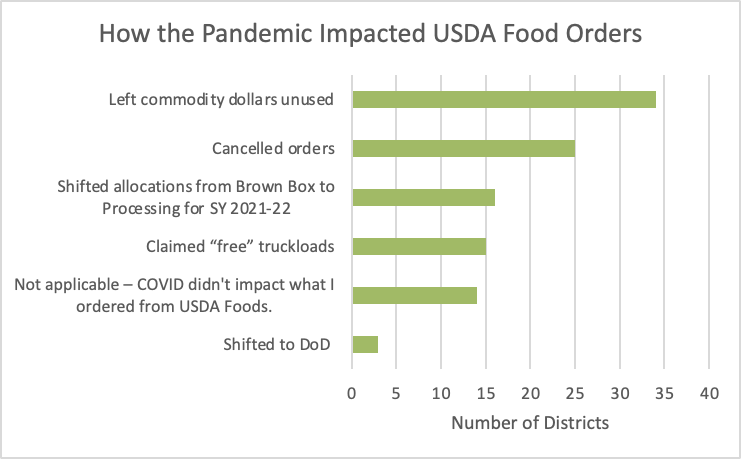
When asked how the pandemic impacted USDA food orders:
- 14 districts, 21% stated that the pandemic did not impact their USDA foods orders
- 15 districts, 22%, claimed additional free truckloads
- 16 districts, 24% shifted allocations from Brown Box to processing for 2021-22
- 25 districts, 37% cancelled orders
- 34 districts, 51%, left commodity dollars unused
Three districts, 4%, noted that they shifted funds into DOD Fresh to use up entitlement when noting other ways their USDA food orders were impacted. More districts may have taken the same steps and did not share since it was not a specific option to select in the survey.
When participation was low, half of the districts left commodity dollars unused. The cancellation of orders and shifting funds to processing align with the drop in scratch cooking. It will be interesting to see how districts leverage USDA foods when participation increases with universal meals and students back on campus
Key Takeaways
Fewer school districts were scratch cooking during the pandemic, and their utilization of USDA Foods reflects the decrease in meals served and a switch to heat-and-serve meals. From space constraints, labor shortages and safety concerns, the pandemic impacted a school district’s ability to scratch cook.
The pandemic provided the opportunity for the public to truly understand the vital role that school food service plays in the national food system, brought to light the prevalence of food insecurity, or potential food insecurity in our country as well as the public’s expectation that the government is responsible for ensuring that the basic need of food is met for all children. Expanding access to school meals reduces childhood food insecurity, and the extension of universal free meals for the 2021-22 school year is a step in the right direction. Universal free meals must be permanently extended to ensure increased, sustainable and equitable food access for all students, beyond the pandemic.
We then must go further to ensure that the increased access to the best quality, freshest, nutritious meals that consider environmental impact, fair labor, and equity are scratch cooked. School districts have plans to increase the amount of scratch and speed scratch cooking offered on their menus. To support their endeavors, providing funds for equipment and staff training are paramount. Including definitions for scratch and speed scratch cooking in the CNR as well as a method for determining the amount of scratch cooked items on a menu will create alignment among districts around scratch cooking and provide a foundation for moving forward. Our nation’s children and families depend on school meals, and we must provide school districts the support they need to offer the type of food that all students deserve.







